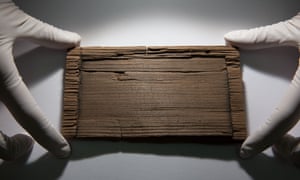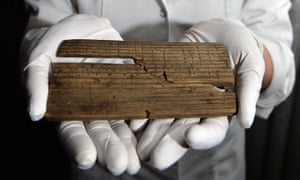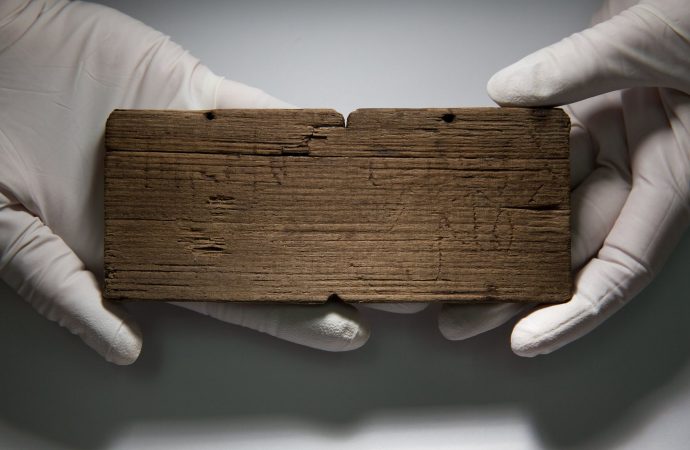Early writings found under office block being cleared for new Bloomberg HQ give glimpse of Roman London
Tertius the Brewer, Junius the Cooper and Julius Classicus – the up-and-coming military commander who would turn traitor against Rome a decade later – have sprung back to life from the first decade of Roman London, their names – along with the first reference to London itself – miraculously preserved on writing tablets in a sodden hole in the heart of the City.
The wooden tablets, preserving the faint marks of the words written on bees wax with a metal stylus almost 2,000 years ago, are the oldest handwritten documents ever found in the UK.
The tablets were found under a 1950s office block in the still smelly, wet mud of the lost river Walbrook, as the site was being cleared for a huge new European headquarters for Bloomberg.
“They give us a glimpse into a carpet-bagging community in the new wild west frontier of the Roman empire,” said Roger Tomlin, the expert on early Roman writing who spent a year poring over the faint scratches on slivers of fir wood recycled from old barrels.
The oldest tablets, one of which was addressed “Londinio Mogontio” – to Mogontius in London – come from a layer securely dated to the first decade after the Roman invasion in 43 AD, through the timbers and coins also found.
That makes it the earliest reference to the Celtic name the Romans chose for their new settlement, written half a century before the Roman historian Tacitus used the name in his annals.
Another tablet, the earliest legal document and the earliest carrying a date from Roman Britain, was written on 8 January AD57, when Tibullus wrote promising to repay Gratus – both men described as freed slaves – 105 denarii, half a year’s pay for a Roman legionary, for goods delivered.
In total there were 405 writing tablets, 87 of which Tomlin succeeded in deciphering – a process he described as “code-breaking”.
Some of Tomlin’s carpetbaggers got rich quick. Tertius the brewer is almost certainly Domitius Tertius Bracearius, who is also known from a writing tablet found at Carlisle – and so by about AD85 had a business stretching the length of the new Roman territory. Only the outer flap of the tablet survives, addressed to him.
It was a dynamic community. Another tablet records an order of 20 loads of provisions to be delivered from Verulamium – modern St Albans – to London, within a few years of the Boudiccan revolt, in which both settlements had been razed.

Another is addressed to “Junius the cooper opposite the house of Catullus”, whose barrels may have been broken up to shave down into more tablets. The tablets originally came in pairs bound together, with a shallow recess filled with beeswax blackened with lampblack. The letters were scratched into the wax with a sharp stylus and, though the wax had dissolved over the centuries, the words have been deciphered from the faint scratches in the underlying wood.
![A Roman waxed writing tablet dated AD 80-90/5, which translated reads: “You will give [this] to Junius the cooper, opposite [the house of] Catullus”.](https://i.guim.co.uk/img/media/c0c4c3127805acb985372aaef9d81243afcbec92/0_64_4000_2400/master/4000.jpg?w=300&q=55&auto=format&usm=12&fit=max&s=a6e473bc8496d4ad1bb69054a4681e2a)
Only 19 legible tablets had previously been found across London. The new treasury includes the names of nearly 100 individuals, and the tablets include legal and business documents, bills and promissory notes, and somebody practising the alphabet and numerals – perhaps evidence of the earliest Roman school.

The oldest are less chatty, but earlier than the cache of tablets found at Vindolanda near Hadrian’s wall, which include requests for warm socks for frozen soldiers serving on the northern frontier.
Tomlin was astonished to find the earliest use of the phrase “per panem et salem”, by bread and salt, recorded as a proverb reflecting on the simple life of the virtuous ancients by Pliny. The letter asks the recipient “by bread and salt” to send 36 denarii, which Tomlin interprets as “you’ve had your free lunch, now I need some money from you”.
Another name known from history is Classicus, “prefect of the Sixth Cohort of Nervii”, commander in the AD60s of an auxiliary infantry cohort, probably through the influence of his cousin, Julius Classicianus, who was an official in Britain in AD61-65. In AD70 Classicus, by then in charge of a cavalry regiment on the Rhine, would join the rebellion against Rome in the power struggle after the death of Nero: his ultimate fate is unknown.

Most of the tablets were imported in rubbish, including stable sweepings, from across the settlements as the Romans brought in tonnes of landfill to build up the sodden river banks and make building platforms. However, some were found within the foundations of a small square timber room, which Jackson described as “the oldest office in England” and probably since the tablets were legal documents, the oldest law centre too.
The site was known to have produced sensational finds when the office block was built among the postwar bomb sites in the 1950s, including the temple of Mithras, which Londoners queued around the block to see in 1954. As part of the current project, its remains are being relocated to its original site.
The archaeologists feared there might be little more to find, as so much would have been destroyed by the deep cellars of the office block. Instead, finds poured out from the one small stretch of the Walbrook that had been preserved undisturbed by chance.
The tablets are still being worked on by the scientists, but a selection will go on display – with hundreds of other artefacts from the site – when the Bloomberg building opens in 2017.
Source: The Guardian

































Leave a Comment
You must be logged in to post a comment.